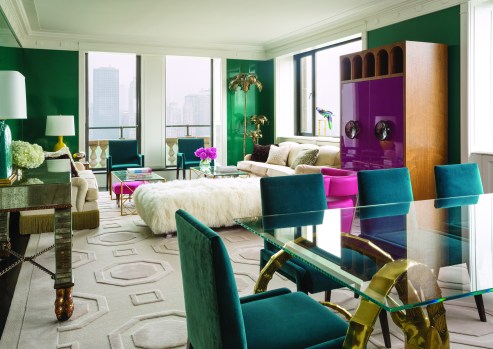
I like interesting stories, and I like interesting homes. So, when a new book — “Authentic Interiors: Rooms That Tell Stories” (Gibbs Smith, $45) — hit my radar, I grabbed it. The 224-page, picture-rich hardcover features14 client-inspired projects including the author’s own home.
So I rang up the author, interior designer Philip Gorrivan, to discuss the secret to designing rooms that tell not just stories, but our stories. (Because despite what they say, a lot of designers tell their stories.)

“If you’re going to design your home, whether a grand house or a shoebox apartment, whatever the budget, make sure your interior space is an extension of who you are,” he said over the phone. “This, after all, is where you come home, sleep and live.”
This is one of those easy-to-say, harder-to-do design maxims, so I turned to the pages for clues. For one couple — a screenwriter and newspaper editor — Gorrivan used posterized black-and-white images of famous faces. For a Brazilian couple’s New York City apartment, he incorporated saturated tones from the tropical rainforest, painting walls in a lacquered emerald and incorporating fuchsia furnishings.
Q. Before we talk about other people’s stories, what’s yours? What was your childhood home like?
A. Because my parents had different interests, our house was a mix of antiques and modern furnishings. It was by no means “decorated.” We lived in Portland, Maine, where we had these long bleak winters. My family had this old farmhouse, which became a repository for family hand-me downs and heirlooms. To amuse myself, I spent hours exploring all these pieces. I may have been the first 10-year-old to ask for a subscription to Architectural Digest.
Q. Interior design wasn’t your first career …
A: After college, I worked in sales, got married, had children and was working to pay the bills. When 9-11 hit, we were living in New York. It made me rethink everything. I decided then to do what I loved. I went to work for an interior design firm to learn the ropes, and after two years, went out on my own. My break came when House & Garden magazine asked me to design a room for a show home they were putting together a 12 by 8-foot laundry room. I made the most of it.
Q. Although your rooms tell your clients’ stories, you clearly have a signature look. How would you describe it?
A. I come from a love of textiles and fabrics, color and pattern. I like to align with great design firms of the 20th century to create a look I call classic modern, a mix of periods that speak to both the home and the homeowner.
While I have a lot of respect for neutrals and earth tones, color is powerful and transformative. The chapter titled “Reinvention,” for example, features a New York apartment we made over after the owner got divorced. He was living in the same place he’d shared with his ex-wife and wanted it to feel completely different. Painting the walls bright spring green felt like a new beginning.
Q. Beautiful interior design books cover coffee tables everywhere. How is your book different?
A. The word “authentic” is in the title because it’s important to me. Authenticity is critical in any creative endeavor. I wanted to convey that and emphasize that a successful interior should speak to the architecture of the house or apartment, to the surrounding geography and ultimately to the homeowner.
Q. What if the homeowner is a couple with different interests and tastes?
A. Every couple disagrees on looks. We negotiate. A successful home design includes elements that reflect all inhabitants, which ultimately makes the interior even more unique.
Q. What makes you cringe when you walk into some homes?
A. Furnishings that are totally out of scale. A sofa that is way too big or art that is too small can ruin a room.
Q. How can we inject our story into our homes?
A. Think of what you love and want to surround yourself with: your children, your pets, your travels, your roots. Some clients don’t want any reminders of their work once they get home. Heritage also matters. I always want to know where my clients grew up.
Q. What do you want readers to take away?
A. I hope they read the different stories and see how stories can come alive in design. I hope they see how the best designs come from the inside out and come away thinking, maybe I can do this, too.
Marni Jameson is the author of seven books including the new “Rightsize Today to Create Your Best Life Tomorrow.” Reach her at [email protected].
